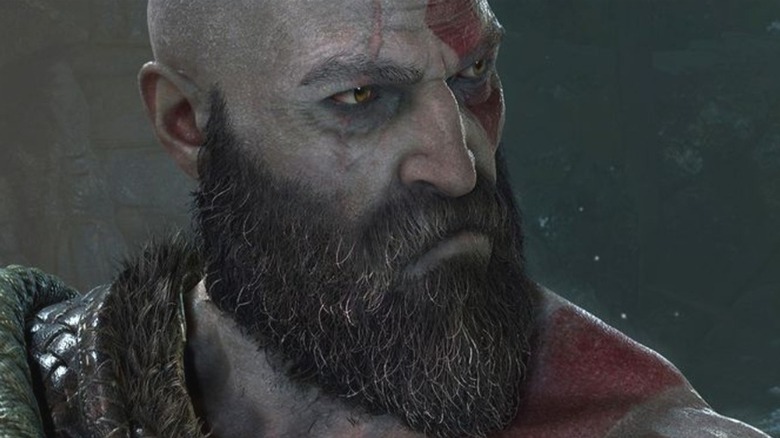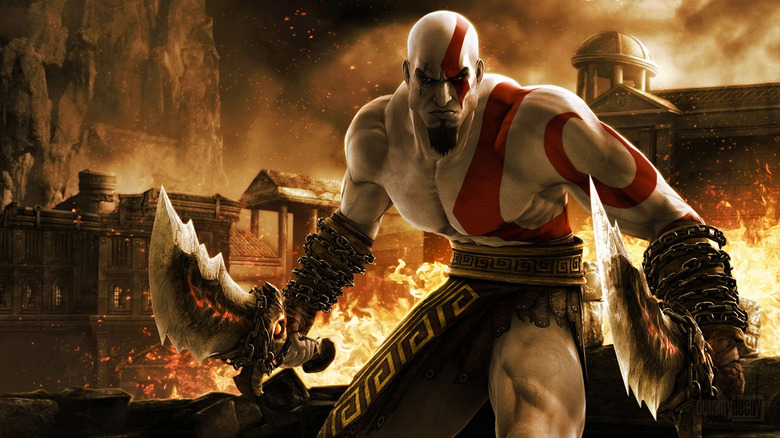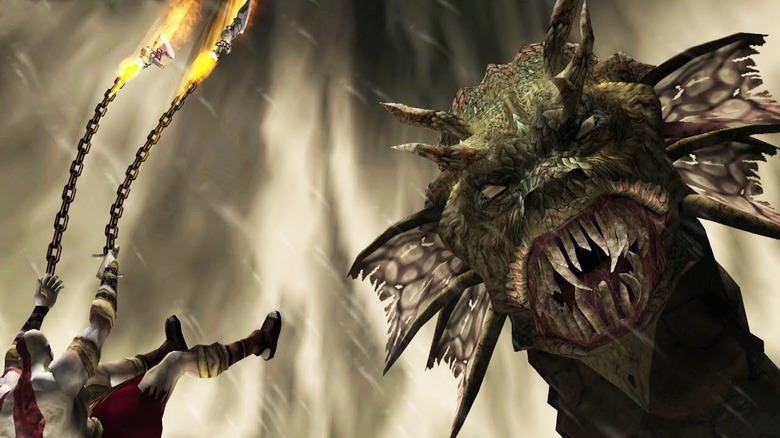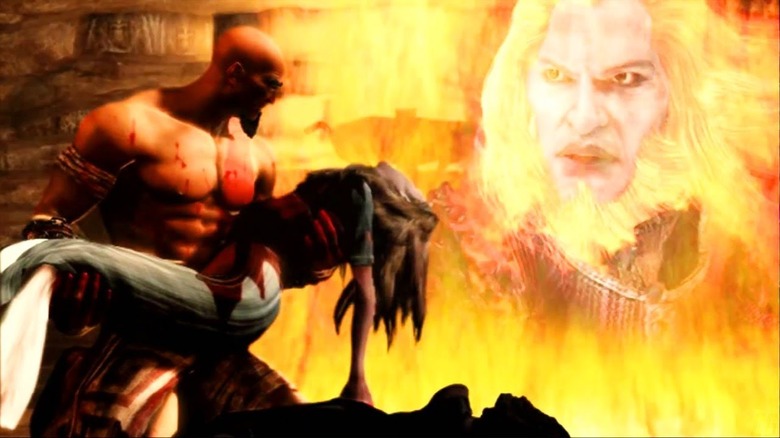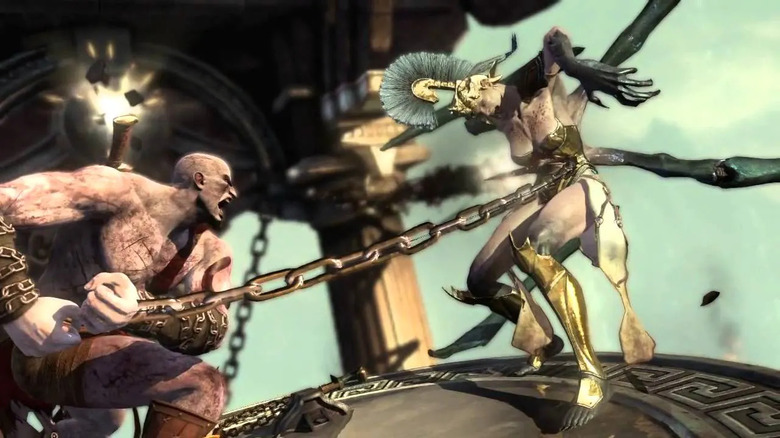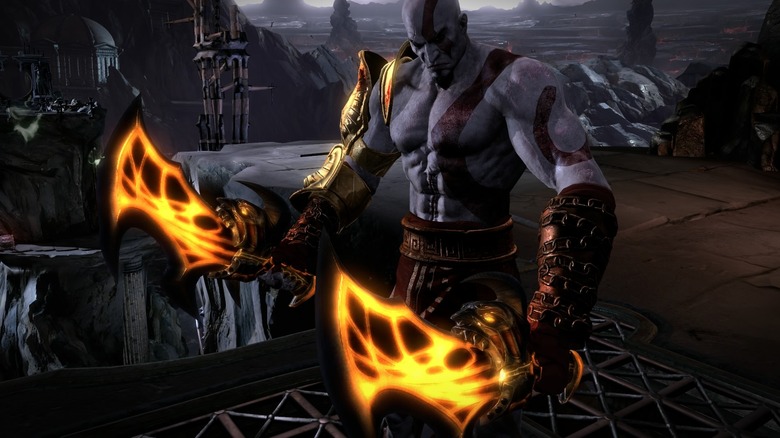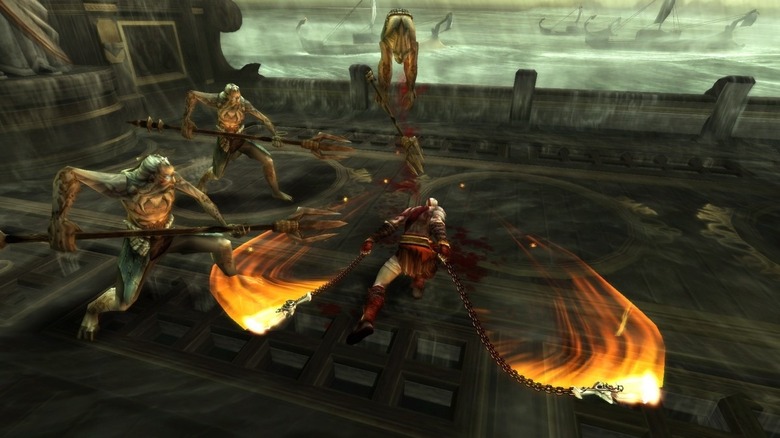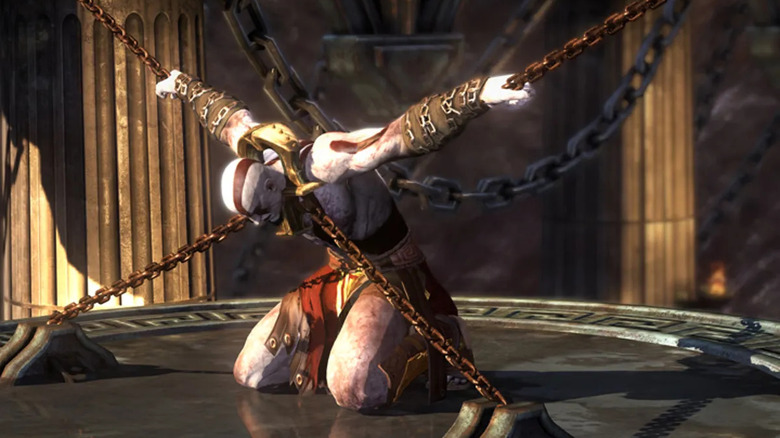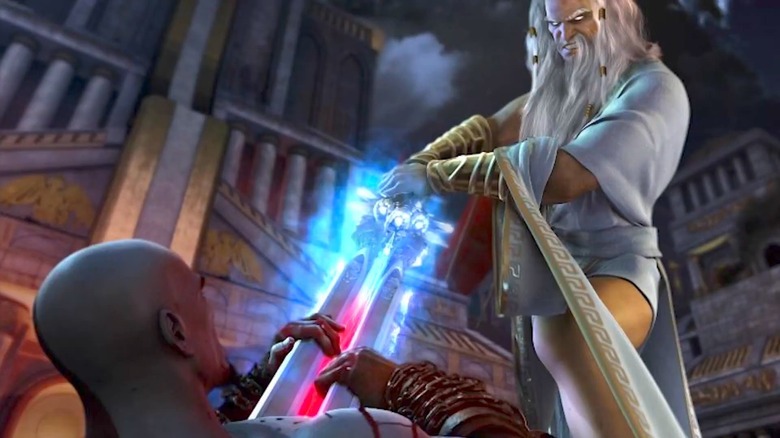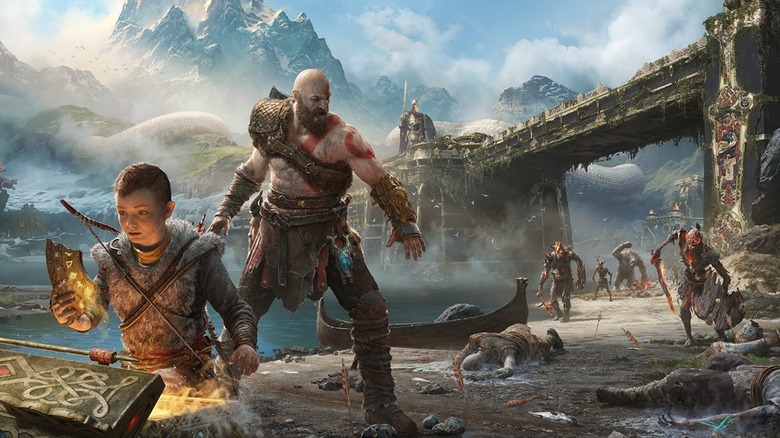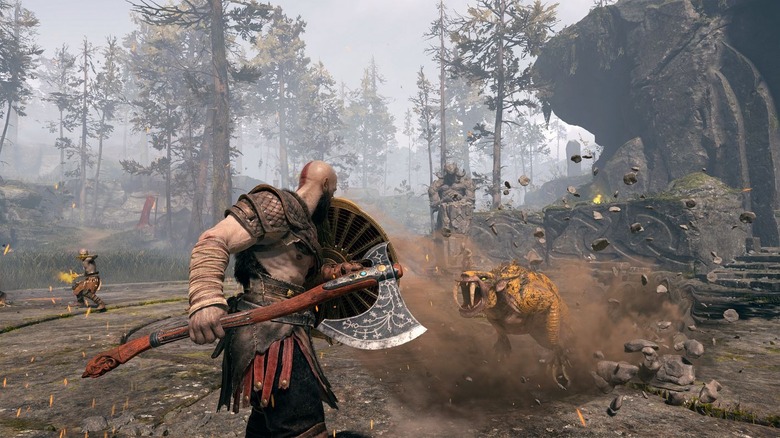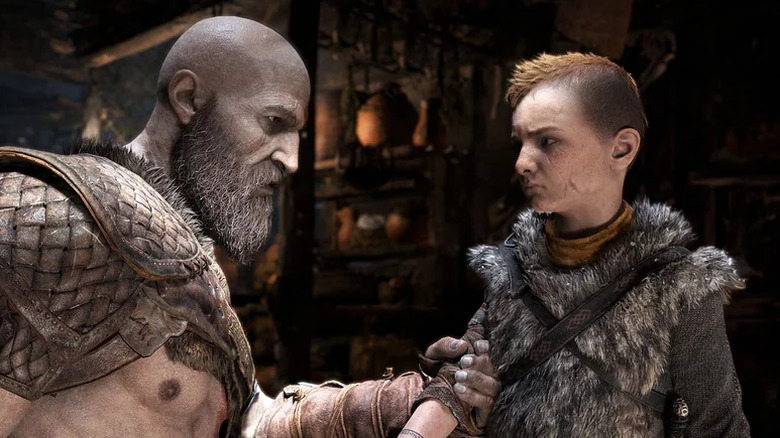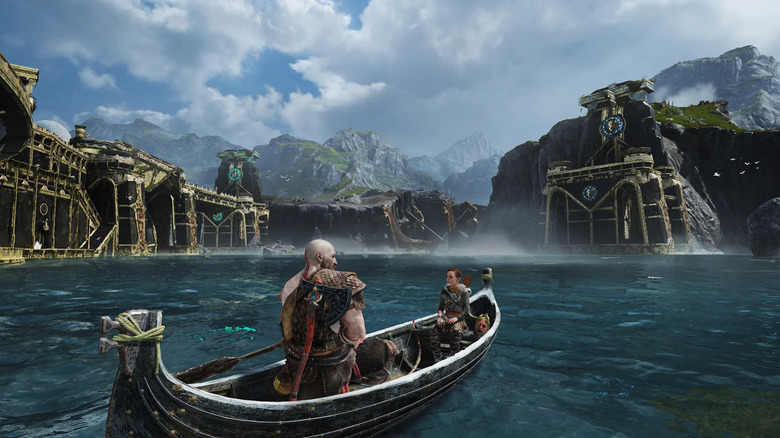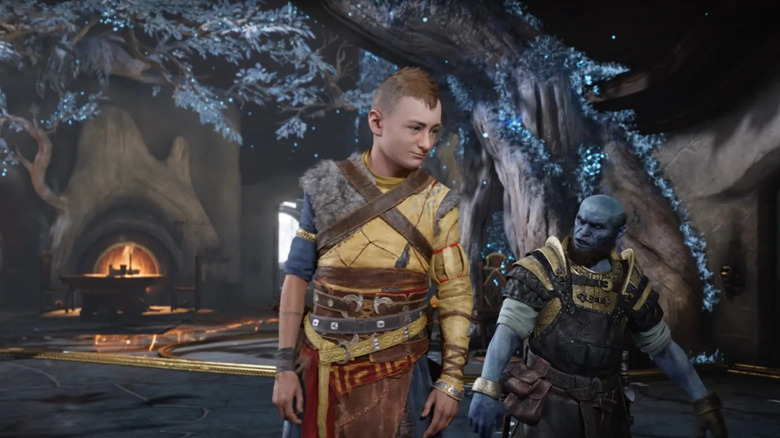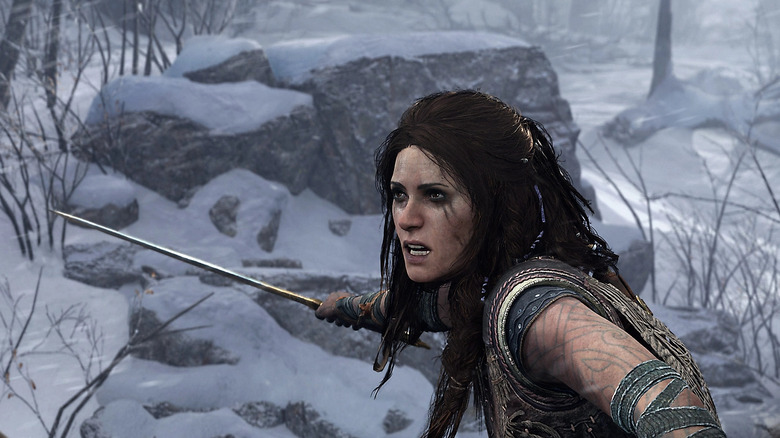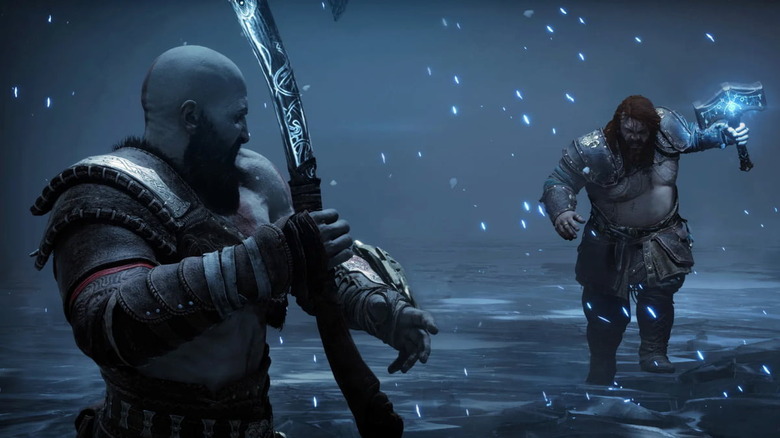How God Of War Has Drastically Changed Over The Years
The "God of War" series is one of PlayStation's flagship exclusive franchises. The first entry in the series was released in 2005 and was welcomed with incredible critical acclaim. The game's deep combat system, sense of scale, and gory graphics all struck a chord with players, cementing it as a PlayStation 2 classic. With the original title's incredible success and popularity, it makes sense that Sony decided to continue the series with numerous sequels, spin-offs, and ventures into other media like comics.
These efforts are still ongoing, and "God of War" remains one of the most iconic and high-profile exclusives in PlayStation's strong stable of first-party titles. Over the years, however, "God of War" has drastically changed. It has evolved with PlayStation hardware and its capabilities, but it has also matured along with audiences. Here's how the "God of War" franchise has evolved over the years, from the beginning to the eve of "Ragnarok."
God of War's action-packed origins
The first "God of War" is centered around players progressing through linear levels on Kratos' path of revenge against the Greek gods. These levels are structured around platforming sections, enemy encounters, and occasional puzzles. This helps keep the game's pacing moving quickly, as the style of challenge that players have to overcome change frequently. It also allows the levels to feel very distinct from one another, especially as they're broken up by large-scale boss fights and set pieces.
The real standout in the first "God of War," however, is its combat. Using his now-iconic Blades of Chaos, Kratos tears through crowds of enemies, stringing together long attack combos. Players can juggle enemies on the ground or in the air, eventually whittling down their health enough to perform cinematic finisher moves that would reward Kratos' efforts with health and a satisfying explosion of gore. Basically, "God of War" arrived as a dream come true for action fans.
Massive boss fights set the tone for the series
As mentioned previously, the original "God of War" trilogy packs in some jaw-dropping boss fights. These take full advantage of the series' Greek mythology and setting by having Kratos face off against towering gods and colossal monsters. These boss fights are still amazing to play through, each filled with personality, cinematic flair, and their own unique challenges. Players are ultimately able to kill off the boss with a creatively brutal and bloody finishing move that personifies Kratos' burning rage.
A great example of this can be found in the first boss fight against the Hydra. The fight takes place on a cargo ship in the middle of a violent storm, providing an exciting backdrop for the entire encounter. The player first has to deal with the Hydra's two smaller heads that have broken through the ship's hull. The two heads can suck Kratos in and attack him, meaning players have to deal with both of them at the same time before he eventually drives spikes through them. Kratos then climbs the mast to face the main head of the Hydra, which he impales on the mast after breaking the mast with the beast's head.
This first boss fight established a fun hook and structure that has carried through each iteration of the series.
A Greek tragedy
With "God of War" being set in the world of Greek Mythology, it makes total sense that the story would be heavily influenced by the tenets of a Greek tragedy. It all started with Kratos becoming a feared warrior by leading a regiment of soldiers from the legendary city-state Sparta. Through his decisive victories on the battlefield, he quickly achieved legendary status among his allies and enemies alike. However, his unit was eventually defeated by an army of barbarians. In the final moments of the battle, Kratos prayed to Ares, the original God of War, and offered to enter his service.
Ares accepted Kratos' offer, gifting him with the Blades of Chaos, which Kratos used to kill the entire enemy army by himself. Kratos then acted as a servant of Ares, traveling abroad and slaying countless people in the name of creating war. However, he was able to cling to his humanity thanks to his ties to his wife and child. Ares sought to sever that tie manipulated Kratos into killing his family in blind fury. He thus swore revenge on Ares and began his path of carnage in the first game. However, despite the violence heavy themes present in the "God of War" legend, the first few entries in the series weren't exactly the most "grown-up" games.
For mature audiences only
"God of War" received a lot of attention from players and media alike because of its extremely mature elements. First and foremost is the game's gore: There are cinematic kill moves for every enemy and boss in the game, and they frequently depict Kratos dismembering his enemies in bursts of blood and viscera. Even outside of those finishing moves, striking enemies will cause large splashes of blood to erupt from them, and Kratos is frequently covered afterward. Even innocent onlookers are often subject to being brutally massacred by large beasts or the other vicious foes that challenge Kratos during his campaign of revenge.
Another mature element of "God of War" that got a lot of attention was its sex scene. The scene contained female nudity and a quick-time event minigame that allowed players to do the deed off-camera. While the players press the prompted buttons, they can hear moans and watch a nearby vase shake until it falls to the floor. These uncomfortable love scenes would become a recurring element in the early days of "God of War," with a full-on orgy breaking out in "God of War: Ghost of Sparta."
God of War's sequels
The success of "God of War" led to it quickly being followed up with two sequels in 2007 and 2010. "God of War 2" was released for the PlayStation 2 and expanded upon the first game's combat systems, graphical capabilities, and sheer brutality. The game saw Kratos officially acting as the new God of War after killing Ares in the first game, only to be betrayed and killed by Zeus. Kratos refuses to stop fighting, however, and tears through the underworld, eventually absorbing the power of the Titan Atlas and vowing to kill Zeus for revenge.
This starts Kratos on a new path of carnage and violence, which leads him into the events of "God of War 3." Along the way Kratos aligns himself with the Titans before being betrayed by them as well. So, he kills his way through nearly all of the Titans and all of the Greek gods in increasingly gory and brutal methods. As he does so, the natural elements of the world that the gods controlled are erased, nearly bringing on the apocalypse as the final price for his revenge on the Gods that ruled and meddled with humanity for so long. Although the games became more visually impressive and exciting, some fans have argued that Kratos' character kind of gets lost along the way, becoming little more than an angry monster by the end. That would eventually change when the series made its grand return...
God of War goes portable
"God of War" didn't just get big console sequels; it also branched out into the world of on-the-go entertainment, albeit with a few changes to the overall formula. The first was a mobile-only game called "God of War: Betrayal." The game abandoned the series' typical 3D environments and movement in favor of classic side-scrolling beat 'em up action, likely because of the limited power of mobile devices at the time. It was also a prequel to "God of War 2" and told a story in which Kratos is framed for an assassination shortly after becoming the new God of War.
"Betrayal" was followed by two games for the PlayStation Portable. The first was "God of War: Chains of Olympus" in 2008 a prequel to "God of War" that follows Kratos during his servitude to the Gods after breaking his oath to Ares. The aforementioned "God of War: Ghost of Sparta" arrived in 2010. This game delved into the tragic relationship between Kratos and his brother Deimos, and also told the story of Kratos trying to learn about his origins after the events of the first game. Both of these games stayed largely faithful to the gameplay template set by the series' mainline releases, only on a slightly smaller scale.
Ascension to multiplayer
The final release of what is known as the "Greek era" of "God of War" was released in 2013: "God of War: Ascension." The game served as a prequel to the entire series thus far and takes place only a handful of months after Kratos killed his wife and child. The story is centered around Kratos' attempts to escape the imprisonment of the Furies after breaking his oath to Ares. The game featured a further improvement of the series' graphics, thanks to the PlayStation 3's hardware that had also powered "God of War 3."
The biggest change that "Ascension" brought to the series was the introduction of online multiplayer. The game's online functionality allowed players to tackle missions cooperatively with up to three other players. The competitive side of the multiplayer allowed two teams of four players to fight against each other in objective-based game modes. Players created their own warriors for the multiplayer mode and were able to swear fealty to one of four Gods, which would in turn allow them to choose different powers and abilities.
Even with these changes, however, some critics felt like the single-player campaign of "Ascension" was more of the same, and longed for the franchise to spread its wings and try something new. It would be a while, though.
God of War 3 gets a celebrated upgrade
The final release in the series before 2018's "God of War" was a remaster of "God of War 3," which was released for the PlayStation 4 in 2015. The remaster received solid praise from critics and took full advantage of the new hardware to make the game look as beautiful as possible. Updates included improvements to the game's textures, offering full 1080p resolution with a 60fps framerate, and adding more detail to the game's lighting engine. Comparisons between the remaster and the original release illustrate that the changes were subtle, but still impactful, as well as a treat for fans who wanted to revisit the climax of the series at that point.
"God of War 3 Remastered" was also released to celebrate the ten-year anniversary of the series. It is impressive just how many titles the series received in that timeframe, and the remaster of "God of War 3" was a fitting send-off for its Greek era. However, some might say that the best was yet to come.
Kratos explores a whole new realm
For the return of "God of War" in 2018, the series was rebooted and took Kratos to the a new realm of Norse Mythology. Players are also introduced to Kratos' new life, albeit long after it began. At the start of the story, Kratos' wife has recently died, leaving Kratos to raise their son Atreus on his own. The game's story then revolves around the two trying to spread her ashes atop the highest mountain in the Norse realms. Along the way, Kratos struggles to keep a handle on his new life while hiding his true origins from Atreus. However, their adventure leads to the Norse pantheon discovering Kratos' presence and fearing his involvement in their affairs.
Along with the new setting, "God of War" also brought massive changes to the game's formula in terms of presentation, writing, and combat. The newest entry in the series also saw an incredible improvement in its visuals, even when compared to the remastered "God of War 3." The game's graphics looked even better with the ports of the game to the PlayStation 5 and PC. Though the series was already a fan favorite, 2018's soft reboot allowed "God of War" to reach all new heights.
Old god, new tricks
One of the key overhauls that the new "God of War" brought to the series was a new take on combat. To start, Kratos no longer has his Blades of Chaos at the start of the game and instead uses the hefty Leviathan Axe. The game's combat system still puts an emphasis on chaining incredible combos together, but it removes the aerial element seen in previous titles. Instead, Kratos stays almost entirely on the ground and has new tools to work with, like a shield to block enemy attacks and runes that grant him access to unique abilities.
The combat is also heavily changed by the inclusion of Atreus, who has a bow that can shoot enemies with multiple types of arrows with a range of effects. The new combat system also allows Kratos to fight with just his fists, which builds up a stun bar on enemies and allows him to perform a finishing move much faster. One element of the combat that was kept, however, was the visceral brutality. The finishing moves are gory and axe swings are impactful, which keeps the combat feeling as detailed and fun (and occasionally nasty) as its predecessors.
God of War's new maturity
One of the most impressive changes brought to the series with 2018's "God of War," however, was its new approach to its storytelling and narrative, which is reflected in its combat. Combat is still presented with plenty of blood, but it is somewhat dialed back from previous titles to feel more realistic. Even if the game still shows Kratos tearing a man in half with his bare hands, it feels more pared down and grounded than the cartoonishly gross explosions red found in the original games.
The game's narrative also takes a more mature route by focusing more on the emotional journey of Kratos and Atreus, which is filled with nuance and complexity. Kratos struggles with grieving the passing of his wife, who helped him find a new life and inner peace, all while trying to figure out how to be a single father as well. The situation is further complicated as Kratos begins to see many of his worst aspects appearing in Atreus, which in turn leads to internal conflict as he realizes he is unsure of how to guide Atreus towards a better path. As the story of 2018's "God of War" reaches its end, their loyalty to one another is challenged time and time again, but love wins out — showing that Kratos has greatly matured from his early days.
God of War 2018 is a cinematic experience
Rather than having a floating camera high above Kratos and the environment, "God of War" employs a close camera that looks over Kratos' shoulder. This not only has a huge impact on how combat is played, but also gives players a different perspective on the game's world. Rather than seeing above everything, Kratos is frequently dwarfed in comparison to the massive structures and monsters surrounding him, giving the Norse realms a greater sense of scale.
Another interesting aspect of the camera is that it never cuts. There are no loading screens in the game, and the camera simply floats away seamlessly from Kratos' shoulder when a cutscene begins. This makes the game's adventure feel uninterrupted and keeps the player immersed in the action and narrative beats of every scene. It also breathes new life into the "God of War" series' tried and true cinematic boss fights. The first boss fight with Baldur, for instance, is breathtaking in its raw energy and the details seen in every frame of animation.
A new playable character in Ragnarok
With the release of "God of War Ragnarok," the series has continued to evolve in how it approaches storytelling. One of the most transformative changes can be seen in the introduction of a second playable character. In certain sections of the game's story, players control Atreus on his own, completely leaving Kratos behind. Introducing a second playable character to the game's main story introduces some interesting opportunities, and "Ragnarok" capitalizes on them to make its storytelling even more effective — particularly towards the ending of the game.
Making Atreus playable effectively expands the scope of the game's story, allowing many events to transpire (and be playable) in multiple places at the same time. This allows the developers to tell a more multifaceted story, without restricting it to a single perspective or setting. Putting players directly in control of Atreus for segments of the game also helps flesh the character out more, providing a more direct look into his thoughts and personality. It also presents an opportunity to mix up the game's mechanics and pacing, thanks to Atreus' different fighting style.
Expanding the series' themes of revenge
"Ragnarok" largely continues the themes established in 2018's "God of War." As players progress through the story, they watch Kratos continue to battle the demons of his past while deepening his relationship with Atreus. However, "Ragnarok" finds new ways to expand upon these themes. In its predecessor, these ideas were primarily explored through Kratos and Atreus' interactions with one another. This obviously worked very well, but the newest title in the series goes through extensive efforts to use its side characters to explore its themes as well.
Two prime examples of this come from Freya and Mimir, who both struggle with their past actions in ways similar to Kratos. Freya does so in regard to her history with Odin and her dead son Baldur, while Mimir enlists Kratos' help in undoing some actions from his past that he greatly regrets.
Similar parallels can also be drawn between Kratos and Odin. Kratos' efforts throughout the game repeatedly see him going against prophecies of his death during Ragnarok. It is only when he spares Thor that he is able to break free from fate and take control of his own destiny. Inversely, Odin's anger and lust for power means he repeatedly fails to defy fate, ultimately leading himself down the path of ruin. Over the course of the game, Kratos also grows to trust and relinquish some control over Atreus. Odin fails to do similarly with Thor, resulting in both sets of father and son seeing very different outcomes.
The future of God of War
Given how successful "God of War" was with critics and fans, it is no surprise that players were immediately hopeful for more content. And in fact, there were plans for DLC content to be released, but they were ultimately scrapped because the game director's ideas for it were too expansive (per Kinda Funny). The developers have confirmed that "God of War Ragnarok" is the definitive ending of the Norse storyline, so many fans are already thinking about where it could go in the future.
When thinking about all of the different mythologies that "God of War" could explore next, it is hard to not get excited. "God of War" has obviously tackled the Greek and Norse pantheons, while a prequel comic for 2018's "God of War" saw Kratos exploring elements of Egyptian mythology as well. This still leaves many different avenues for the series to explore, but it could be that it won't be Kratos exploring them.
Given how well Kratos' character arc has been explored over the years, it seems plausible that Atreus could be the future protagonist of the franchise. Some fans have already theorized that the series could be heading in this direction. Whatever happens next, one thing's for sure: The "God of War" series will continue to evolve in surprising ways.

